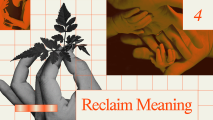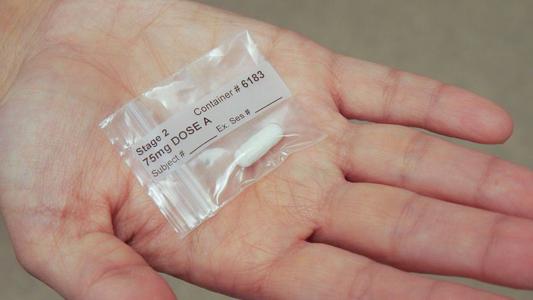Among the psychedelics currently being studied, ketamine’s impact on treatment-resistant depression may be the most dramatic, and ketamine infusion clinics are popping up around the country.
The drug, used as an anesthetic by doctors and vets (and to party by club kids) is a potent and fast-acting antidepressant, outperforming traditional antidepressant medications by a considerable margin.
Patients with treatment-resistant depression who go on new meds have a 10-20% chance of response, John Krystal, a professor of psychiatry and neuroscience at Yale, previously told Freethink.
“Ketamine produces response rates more like 50 to 80%,” Krystal, whose lab discovered its antidepressant potential, said. Those antidepressant effects can first be felt within a few hours of treatment.
That tracks with the experience of Melanie Malloy, clinical director of the Brooklyn Heights clinic of Ember Health, which provides ketamine infusion treatments. Ketamine infusion works for around 82% of Malloy’s patients.
Dope Science is here to explain what ketamine infusion is, what we know about how it works, and how it feels.
Ketamine Infusion: The Basics
What is ketamine infusion therapy? While ketamine can be taken orally, in a nasal spray, or via syringe, the most well-studied method is by IV ketamine infusion.
Using 24 gauge needles — the small needles are often considered pretty painless, Malloy says — the clinic will administer the ketamine while patients sit in comfortable chairs and relax, often with eye masks and music.
What does ketamine infusion therapy treat? Malloy’s practice is focused on depression, which she says is the best studied application of ketamine infusion therapy.
The drug is also being studied as a potential treatment for OCD, anxiety, addiction, and chronic pain, DoubleBlind reports.
What is ketamine? Ketamine’s been around since 1962. It was originally formulated as an anesthetic; while well known for being used in animals, ketamine is used for people as well.
The drug is on the World Health Organization’s essential medicines list, a collection of “efficacious, safe, and cost-effective” drugs that the WHO considers essential to fulfilling the minimum needs of a basic healthcare system.
Ketamine is a potent and fast-acting antidepressant.
That’s because it is considered a relatively safe anesthesia option. Ketamine has a fairly wide margin for error in dosing — something that can be fatal or disabling with other anesthetics. It also does not slow down breathing or blood pressure.
It’s little wonder the drug finds its way onto battlefields.
Ketamine has an unusual side, however; taken in small doses, the drug produces intense and uncanny psychoactive effects — most famously dissociation.
Producing a feeling of detachment from the self and reality (I always picture Doctor Strange’s astral projection, personally), other dissociative drugs include PCP and DXM, the active ingredient in Robitussin.
That feeling of detachment can also be experienced during ketamine infusion therapy. But rather than being a side effect, research points to that potentially being what we want.
How does ketamine infusion therapy work? Ah, welcome to both the most frustrating and fascinating part about neuropharmacology.
“I think people would be surprised at how many drugs we truly don’t understand the mechanism of action,” as Lisa Monteggia, professor of pharmacology and director of the Vanderbilt Brain Institute, once laid out to me.
Meaning, we don’t know what ketamine is doing in the brain to produce that antidepressant effect.
Ketamine seems to be causing the brain to respond to its introduction by regrowing synaptic connections.
But people like Monteggia are working on it, and here’s what we’ve got thus far.
Rather than controlling neurotransmitters like serotonin — the focus of traditional antidepressants — ketamine seems to impact the brain in a different manner.
Instead, ketamine seems to be causing the brain to respond to its introduction by regrowing synaptic connections.
“The animal data very clearly suggests that synapses that were lost are restored rather than the creation of random new synaptic connections,” Krystal tells me via email.
Krystal and Malloy think of it as restoring plasticity to the brain, restoring synaptic connections that had winked out. Or, kind of like fertilizer for the brain cell’s branches, as psychiatrist Lori Calabrese told DoubleBlind.
Getting Ketamine Infusion Therapy
Does insurance cover ketamine infusion? Using ketamine for depression or other mental health conditions is what’s known as “off-label” use, because the drug is being used for something other than what it was officially approved for.
This isn’t uncommon, by the way, or illegal. But it does have ramifications when it comes to paying for it. For the most part, insurance providers do not currently cover ketamine infusion therapy, but they may reimburse some, or all, of the cost.
At Ember, patients pay $500 for their infusions, with a sliding scale for patients who may have trouble affording the therapy. The patients can submit their bill to their insurance provider, which may then reimburse the patient directly. But that depends on having out-of-network benefits, Malloy says.
What to look for in a clinic: Multiple bodies, including the American Society of Ketamine Physicians, Psychotherapists & Practitioners (ASKP3) and the KRIYA Institute, have begun putting together lists of standards and guidelines for ketamine infusion therapy.
- Do they perform a medical assessment before you begin treatment?
- Do they perform a psychiatric assessment before you begin treatment?
- Do they help formulate a plan going into treatment?
- Do they provide psychological support before, during, and after the treatment?
You should also be on the lookout for ketamine infusion clinics that seem to be overhyping what the treatment can do, offering it for uses not well supported by science, or claiming to provide special formulations of the drug. Also look out for clinics that don’t screen patients and have inadequate staff and credentials — especially a lack of mental health professionals.
A STAT investigation found those issues were unfortunately not uncommon.
Who administers the therapy? As DoubleBlind reports, your ketamine infusion therapy may be administered by a number of different healthcare providers.
According to ASKP3, the majority of ketamine infusion clinics are run by anesthesiologists, psychiatrists, certified registered nurse anesthetists, or other mental health professionals.
In their standards of practice, ASKP3 stakes out the position that “no one field of medicine can appropriately cover all of the bases,” and that the field requires “a team approach with each specialty offering unique insights to a complex subject.”
A ketamine infusion experience: Malloy walked me through what a patient would experience at Ember; different clinics may do things in different ways, but the broad strokes should be pretty applicable.
The majority of Ember’s patients are referred by their mental health provider. First, potential patients have a 20-minute intake call about their medical history and depression symptoms. “If they seem like a good candidate, we’ll invite them to fill out intake forms and book a visit,” Malloy says.
While they’re preparing for you to come in, Ember speaks with your mental health provider — something that may not be done across the board at ketamine infusion clinics, but is required at Ember, which only accepts patients seeing professional mental health practitioners. Ember Health then works with those practitioners, taking a collaborative approach.
Your first session at Ember is two hours. The ketamine infusion itself takes 40 minutes, Malloy says, but the first visit is longer to allow time to “answer any questions, allay any fears.”
There’s a crash course in ketamine biology, and you’ll be walked through what the treatment is going to be like and what you may feel.

What ketamine infusion is going to be like and what you may feel: As per usual when we’re talking psychedelic mental health treatments, you’re gonna need enough ketamine in your system to trip — but not enough to knock you out.
“People should expect to feel an alteration in their consciousness that may feel quite profound,” Malloy says.
“They may feel detached from reality, they may stop feeling that they are in their bodies. They will almost certainly feel a distortion of their time sense, a distortion of place, so that sometimes people feel like they’re underground, or underwater, or in space, or having a very vivid recollection of their childhood home.”
As DoubleBlind notes, “(F)or most people, it’s an overall pleasant and calm feeling, but for some it can feel disorienting or anxiety-provoking” — just one reason why ketamine infusions need to take place in a clinical setting.
Sitting in a big, comfy recliner — Ember also gives you an eye mask, headphones, and aromatherapy — you’re administered a ketamine dose calculated based on your weight.
People should expect to feel an alteration in their consciousness that may feel quite profound.
Melanie Malloy
The IV infusion runs on a pump for 40 minutes; usually patients sit quietly in their altered state, Malloy says, but sometimes they talk, cry, or respond in other ways. Once the infusion is done, they let the patient sit and metabolize the drug for about 10 minutes afterwards, providing a more gentle transition to reality.
Acute effects wear off in about 15 minutes, Malloy says, but you may feel a bit mellow or tired for a few hours, or even the rest of the day. Most patients are functional after their ketamine infusion, but you probably shouldn’t be driving your car or operating heavy machinery.
What comes after: When you see reports out of Johns Hopkins, NYU, Mount Sinai, Imperial College London, or wherever about the mental health benefits of psychedelics, it’s important to realize that those benefits don’t derive from just taking a trip.
Working with a mental health professional to process your trip and take advantage of your altered state is an important step to maintaining any improvements you may make.
“We talk about the neuroplasticity with patients,” Malloy says. “The neuroplastic window that opens up after their treatment that they need to take advantage of; with their therapist, with their work in therapy, with their cognitive techniques.”
The neuroplasticity in question is the restoration of those synapses ketamine seems to inspire; it’s kind of like getting a new lump of clay for the throw wheel.
“The restored connections are operating in a new brain context,” Krystal says.
Are there side effects? There are definitely some potential side effects of ketamine infusion, beyond that foggy afterglow.
“Many patients will experience transient ‘dissociative’ symptoms, nausea, or a brief rise in blood pressure,” Krystal says. “These effects are generally manageable in treatment.”
There’s also the potential for abuse — although that risk seems to have been managed pretty well so far by issuing ketamine infusion in clinical settings.
Esketamine: A version of ketamine known as esketamine has been approved as a nasal spray by the FDA for treatment-resistant depression. According to Krystal, some patients will see their depression alleviated within 24 hours of taking the drug.
“For the first time in 60 years, we have a new antidepressant therapy that isn’t just a spinoff of existing drugs,” Adam Kaplin, a psychiatrist with Johns Hopkins Medicine, says on Hopkins’ site. “For some people, esketamine therapy is revolutionary, giving them the chance to experience life without depression for the first time in decades.”
Esketamine is so named because it is the s-isomer of ketamine; basically, it’s constructed a bit differently than usual ketamine, and is more potent, according to Kaplin.
Crucially, esketamine spray’s very quick impact — within hours or even minutes — worked in actively suicidal patients, when time may be of the essence. Patients may use esketamine in between their ongoing ketamine infusion treatments, as well.
Malloy’s patients come back on average every six weeks, and says that as far as we know, it’s a long-term treatment; some patients have been coming in for the entire three years the clinic has been open.
How you may feel after your ketamine infusion: The impact of ketamine on treatment-resistant depression can be dramatic.
“Ketamine completely wiped out my depression,” a patient told Freethink in a video on ketamine infusion last year.
“It’s definitely like a night and day response,” they told Freethink a week after receiving a treatment.
It’s important to note, however, that ketamine and esketamine don’t work for everyone. There is still a “sizable group” of patients whose depression symptoms don’t subside when given the drugs, Krystal says.
And for those it does work for, they are not a silver bullet; they are a treatment, and a continuing one at that, a way to manage the life-crushing symptoms of abyssal depression.
“Ketamine and esketamine are not magic cures,” Krystal says, but “simply more effective treatments for those patients who have not responded to standard treatments.”
Editor’s note: This article was edited on 5/17. Ember Health says it charges between $300 and $500 per infusion, not between $500 and $1500; across the industry, infusion prices may range up to $1500. In addition, Malloy has been at Ember Health for one year, not three; the clinic has been operating for three years. The article has also been updated to clarify that Ember Health will only accept clients seeing a mental health professional.
If you or someone you know are experiencing suicidal ideation, call the National Suicide Prevention Lifeline at 800-273-8255.
We’d love to hear from you! If you have a comment about this article or if you have a tip for a future Freethink story, please email us at [email protected].






